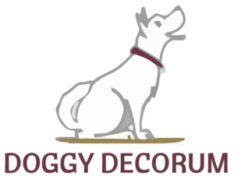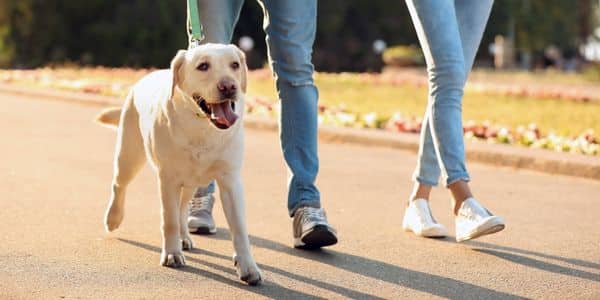It’s March and that means spring is approaching. Quick trips outside to potty brings a familiar memory to our mind: LONG WALKS! With the weather gradually warming, we will soon want to spend more time outside with our dogs. After months of not giving much attention to how we dressed our dogs for a short and cold potty walk, the realization that their gear isn’t as effective anymore, nor is our ability to control our dog’s at the end of the leash. Since we are walking into spring with visions of new collars, harnesses and leashes, now is a great time to also address your dog’s point of being tethered to you. Have you notice how differently they behave on leash vs off? Why is that?
Nature has a specific stride to it, just like walking our dogs. In this month’s blog I will discuss the fundamentals of your dog’s leashed behaviors, along with safe and functional gear and how to desensitize the awkwardness of wearing it. Whether you’re an incumbent dog parent, new puppy or adopted adult dog parent, this information will apply to you. Grab your coffee or water (or wine) and let’s begin…
Leash Expectations: From Your Dog’s Perspective
Have you ever thought about what the actual leash as a tool means to you versus what it means for dogs? For us humans, we use it to keep our dogs tethered to us for safety. It’s lawful to keep your dog on a leash in public areas unless designated otherwise (like in a secured dog park)
Dogs literally have NO clue as to what that thing attaching them to you is for. This is where confusion takes ahold if they are not taught correctly. Most of their activities are OFF leash; in your home, in the backyard, maybe a dog park or doggy daycare. When we attach them to a leash and expect them to walk next to us, everything they understand about how to behave essentially gets tangled in the leash. I believe that being walked outside on a leash is one of the most unnatural activities dogs do. Now that we have broken down that concept, it’s much easier to understand why there can be a disconnect and actual breakdown in behavior. The leash physically prohibits their natural instincts to sniff their surroundings freely, greet the neighbors, chase squirrels, race to say hi to passersby or other dogs.
Let’s talk a little bit more about this for puppies and dogs who have never had exposure to wearing a collar, harness or leash. Their initial reactions might be unexpected and confusing. Common behaviors that you may see are biting the leash, puling away from you, or refusing to move altogether. All of these behaviors are a result of not knowing what to do when put this gear on them. If you’re experiencing any of these behaviors, you will find the section below about desensitizing your dog to their gear very helpful.

Right now, I want you to take a moment to watch how your dog observes outside life versus inside life. It’s a bit different, isn’t it? Inside, life is about 95% predictable, so they tend to be more oblivious to things that occur routinely. Outside though, life is much less predictable and out of our control, which instinctually makes our dogs’ senses that much more heightened. It’s a survival tactic. Dogs primarily communicate by smelling, seeing and lastly hearing. They also have a universal sense which a majority of humans do not have, where they can feel the energy (emotions) of the other beings around them. Ever hear of the phrase “animal instinct”? This is exactly what that means. Humans on the other hand, communicate by hearing, seeing, and then smelling. We behave the complete opposite of dogs.
This is why when we step out the door, the dog forgets they are tethered to their humans. Leash frustration begins, where our dogs do everything they can to break the tension and be able to move at their free will, and go against our goal of a pleasant walk or potty break. All this reactivity occurs because they aren’t aware of the goal. We need to look at these adorable furry faces with compassion (and a bit of humor) and know that us humans have a lot to understand, as do our dogs. Let’s start with knowing what the right gear is and getting our dogs used to wearing it, making it easier to walk them outside.
The Right Gear: Safety, Fit, and Functionality
As mentioned above, gear refers to a collar, body harness and the leash. Choosing which gear is right for you and you dog can be intimidating. There are so many brands and styles on the market. Below are my recommendations and descriptions of each that reflect safety, ergonomic/comfort and functionality:
Collars:
- Flat Adjustable with a quick release buckle for puppies. The quick release allows you to take it off them faster than a belt buckle style. You should tighten the collar so only two fingers can fit between it and the pup’s neck. If it’s too loose, your pup might be able to get its jaw stuck in it or even chew it off.
- However, sighthounds have much narrower heads than their necks and a flat collar might slide off. So they would benefit from wearing a Martingale collar.
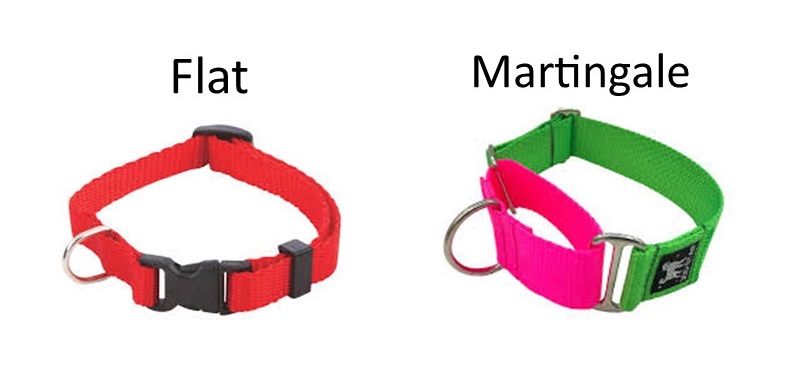
Body Harnesses:
- Over the Head. These harnesses are a safer choice than a step-in style, so your pup can’t pull out of it, they also are more adjustable for the odd body shapes and are ergonomically shaped to avoid the front straps covering the front leg joints and ultimately impeding your on pup’s walking gait. The shape of the harness when laid flat looks like an H or Y. See diagram below.
- No Pull. If you are training your pup not to pull on walks, the aide of an appropriate No Pull harness is beneficial, but alone will not solve the pulling. These harnesses will have an additional metal D ring on the chest to attach the leash to. However, there are many brands that position the ring too low and might cause your pup to trip over the leash. Below are my recommended No Pull Harnesses and where to buy.
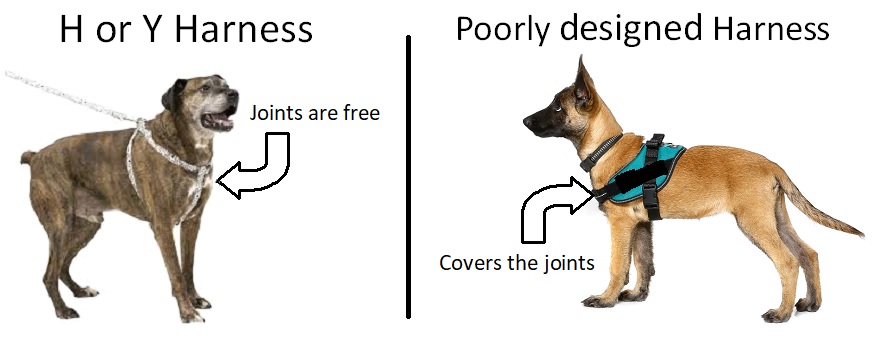
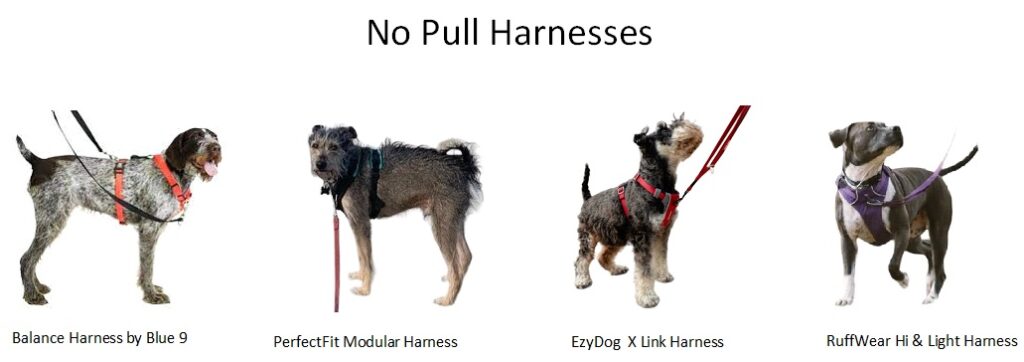
Leashes:
- Fixed Leash with a looped handle is your safest and easiest leash to hold and manage your dogs, especially for training. Many places have laws regarding the length. Generally, a 6 foot leash is a good amount of space between you and your dog. The material you choose is up to you. I personally do not like the bungee leashes. They have an odd tension that really doesn’t provide any comfort on my hands.
- Hands-Free leashes are great for hiking or running. Those are the ones that wrap around your waist or hang horizontally around your body. These should only be used once you have trained your dog to walk politely on a hand held leash.
- Avoid using Flexi Leashes at all costs! They limit how much control you have if you need to get your dog closer to you, you are essentially one hand less for holding things since you have to hold that huge plastic handle and the cord…oh where do I start! Just google the dangers as that’s a whole other blog.
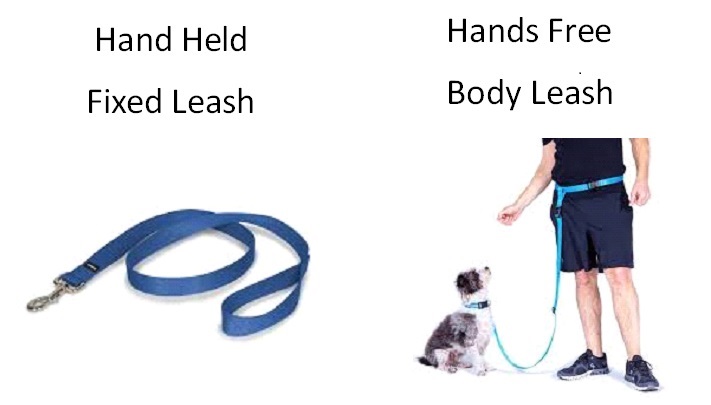
Gear Desensitization: Why Are You Putting That On Me?
For most dogs, especially puppies, its very important that we take the time to introduce the gear we put on them without causing a negative association. The gear includes a: collar, harness and a leash. (A review of my gear recommendations is below.) This introduction step is called- desensitization. Its how we positively associate dogs to wear their gear and ignore it. After all, its just a walking tool.
When you first put a collar or harness on your dog, what was their reaction? Did they ignore it, try to get it off, play with it, or look at you with utter distain? Never mind trying to attach the leash and start walking. You are now exhausted and your puppy has gotten the zoomies. The next time might seem daunting and you just keep trying to find a way to keep their heads still, stop biting, no wait stay here, this is not a toy….

So how do we desensitize? Here are some steps to help lessen the struggle:
- Get some tasty high value treats to create a positive association to the collar and harness. It also helps to keep their mouths away from your hands while manhandling them. I can’t stress this enough! Food is always going to help any situation where your dog is confused about what is going on. High value treats are anything but regular dog treats. Mainly human food such as any cooked meats, cheese, freeze dried liver, peanut butter, etc.
- “Show and reward” – Introduce the collar and harness when your puppy or dog is calm. And not when you need them to wear the harness to go outside either. Sit on the floor or on your couch with your pup, treats and gear. Show each item to your pup, letting them look or sniff it, then say “good” and offer the treat. You don’t have to say anything in this step to get them to look at it. In fact, the less verbal cues the better.
- If you pup tries to chew the gear thinking its a toy, just remove the items and take a brief pause to help calm them and try again. You can also resume at another time when you know they are much calmer.
- Continue practicing the “show and reward” until your pup shows less interest in the gear and more about getting the treat. This indicates they’ve become desensitized to seeing the gear. But let your pup decide when they are desensitized, so you are not forcing them to oblige.
- “Show and reward” – Introduce the collar and harness when your puppy or dog is calm. And not when you need them to wear the harness to go outside either. Sit on the floor or on your couch with your pup, treats and gear. Show each item to your pup, letting them look or sniff it, then say “good” and offer the treat. You don’t have to say anything in this step to get them to look at it. In fact the less verbal cues the better.
- If you pup tries to chew the gear thinking its a toy, just remove the items and take a brief pause to help calm them and try again. You can also resume at another time when you know they are much calmer.
- Continue practicing the “show and reward” until your pup shows less interest in the gear and more about getting the treat. This indicates they’ve become desensitized to seeing the gear. But let your pup decide when they are desensitized, so you are not forcing them to oblige.
- Here we need to introduce the sound the buckles make. Dogs are always curious about what makes noises and if they are nervous or excited about noises, you definitely want to take the time to do this step. Snap the buckle closed and open, praise and reward Repeat a few times during each trial until they are not fussy about the noise.
- Next is placing the gear on your dog without buckling. Lay each item on your dog’s back briefly, then praise and reward. Repeat this step as many times as needed, but do not over practice in one trial.
- Tightening the gear around your dog – Place the collar or harness on your dog and wrap each strap around their neck or body. Pause here to ensure your dog wont dodge off. Remove items, praise, and reward. Repeat until ready to move on.
- Last step! Now, buckle the clasps closed. If your dog doesn’t care that they are wearing the gear, you can praise and reward and even leave them on for a while. Then remove the gear to give them some freedom so to speak. Ideally, all dogs should wear their collars with a name tag on them for safety purposes, but they do not need to wear the harness indoors.
- If they are too concerned while wearing the gear, remove immediately and take a break. Try again when you feel your dog is calmer and ready. Do not feel rushed to get your dog used to wearing gear. Its a foreign concept for dogs. This is why we have to take the time to do these steps with them. If you feel that you are not progressing, call a professional trainer. We do more than teach basic skills! https://doggydecorumllc.com/training-programs/
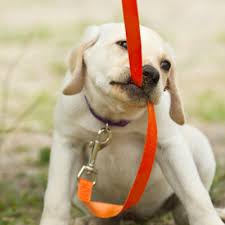
- Now lets desensitize our pups to the leash. To avoid the leash looking like another rope toy, do not dangle it above their heads like one. Keep the leash on the floor when introducing it. (Pro tip: I always keep my leash attached to the harness when storing them. This makes it much easier for me to put their gear on and off with one action, by just putting on the harness.)
- Just like our introduction to the collar and harness, sit with your calm dog on the floor or couch and do the first step – “show and reward”. You can place the leash in your lap or lay on the floor/couch. Repeat until your dog doesn’t try to chew it.
- Next, attach the leash to their collar or harness off the dog, repeat the “show and reward” step above.
- This next step requires movement. Hold the collar/harness with leash attached and walk for a few steps, allowing the leash to dangle a bit towards the floor to make it look realistic, like when you walk with it attached to your dog. While doing this, drop treats on the floor for your pup to forage. I’ve had success with this step as it gives the pup something to focus on other than the leash. If your puppy knows the “find it” game, you can use that but don’t toss the treats far away. Keep them close to you. By cueing them to find the treat, you are also encouraging them to look up at you when you talk, again ignoring the leash.
- Lastly, place the collar or harness with the leash attached onto your puppy. I wouldn’t let them walk away with it dangling along though. Just sit there with them and hold onto the leash while you praise and reward for them ignoring it. When your puppy is successfully ignoring the leash, you are both ready to practiced leash handling and walking skills.
- If needed, you can practice “leash pressure”. This is where you will desensitize the feel of the harness and leash against you dog’s body and not fuss over it. Here’s a tutorial video from a great trainer, Emily Larlham, to show you how that works. Scroll to 5:35, but the entire video is very helpful: https://youtu.be/NUG_J7mIHvc
Now that we’ve addressed gear recommendations, gear introductions, and desensitization, let’s get back to our leash walking behavior foundation training.
Walking Your Dog: It’s Like Driving a Car
When I train my clients to walk their dogs on leash, I use driving references because it makes more sense to me visually and defensively. It’s been a fairly effective way to explain all the steps in training. Walking your dog might seem complicated because there are a lot of components to consider. In order to get our cars moving from point A to B safely, we need to make sure we know how to drive it, put gas in it, make sure there is air in the tires, drive in one lane, watch for other cars, etc.
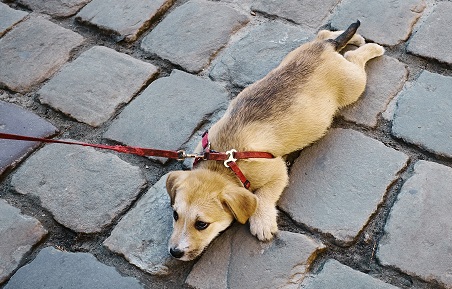
Walking our dogs also has its steps to ensure all goes as intended. Our dogs need to be comfortable wearing their gear, we need to learn how to handle that gear, how to keep our dog safe from cars or other dogs, prevent them from eating debris, picking up their poop, etc. I promise it will be easy to practice.
I’m going to break it down into two categories:
1 = Leash Handling Skills – how you hold the leash safely and effectively.
2 = Communication Skills – how to steer your dog to move in the right direction.
Both = a successful walk for both of you.
Leash Handling Skills
How you hold the leash to use it is a very important concept. This very old picture of me and my first dog, Little Dude, is a very good depiction of the proper way to hold the leash. Notice that I use ONE hand to hold the leash only and is held in the opposite hand from where I position my dog. The leash crossing over my body helps to control the slack. For safer handling, you can hang the loop on your thumb while holding the some of the leash to manage the length. The only other function of the leash is to act as an emergency brake, not as a steering wheel to pull our dogs in the direction you want them to walk.
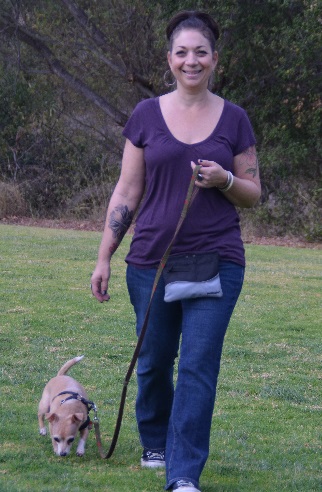
Also notice that the leash is loose and creates a J like shape. This provides your dog some wiggle room to stop and sniff. Allowing your dog to walk with a loose leash also indicates they can continue to walk or sniff about. When the leash tightens, this signals to your dog that they are too far from you and needs to return to your side.
Communication Skills
So, what do we do with our free hand?
That is our communication hand, your doggy steering wheel. This hand needs to be free of the leash and other thing so you can use it similarly like we do for basic obedience hand signals. Though instead of hand signals, our free hand is a visual focal point to lure our dogs by their noses to walk in the right place (vs veering all over the place), change directions and point to things to sniff or look at. And let’s not forget to feed yummy treat rewards to let them know they are doing a good job. Pro Tip: You can also use that free hand to grab the leash slack as part of an emergency brake action.
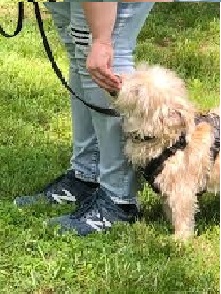
Verbal Walking Cues
In addition to your free hand as a visual aide, we do have verbal cues to talk to our dogs. These cues become more useful once your dog is better at walking nicely without needing constant hand directions. Dog trainers use similar cues to each other, but the exact words really don’t matter as much as how consistent you are with saying them.
So there you have it. Now you are ready to practice the actual walk. Come back next month for a deep dive into how to walk your puppy or dog like a pro!
Cheers,
Andrea
(C) 2023 Doggy Decorum, LLC
